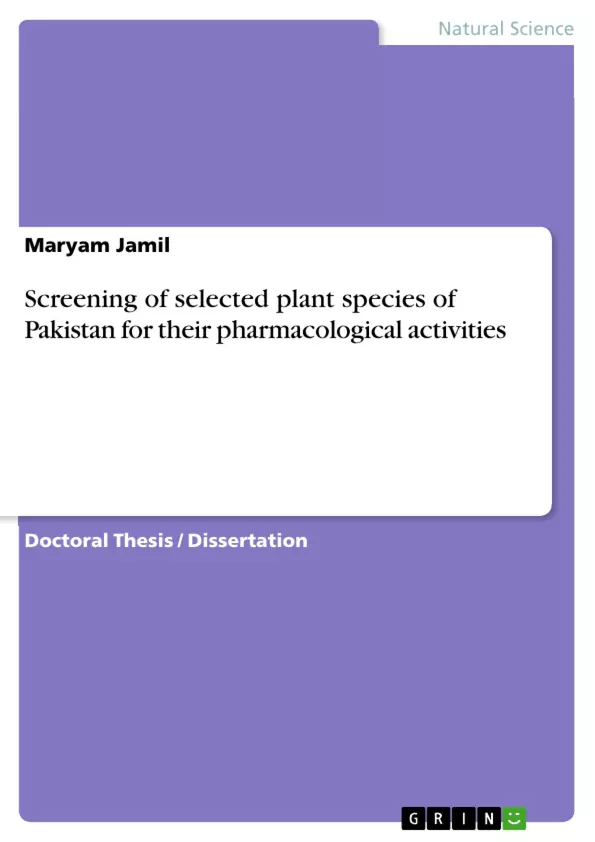In this study four plants (Chrozophora hierosolymitana Spreng, Chrysanthemum leucanthemum L., Ephedra gerardiana Wall. ex Stapf and Quercus dilatata L.) collected from different regions of Pakistan were screened to identify any chemotherapeutic agents
present in them. Seven crude extracts of these plants (leaf, stem and root extracts of C. hierosolymitana, aerial parts of C. leucanthemum, stem and root extracts of E. gerardiana and aerial parts of Q. dilatata) were examined for antimicrobial activity using agar diffusion method and agar tube dilution method, cytotoxicity using brine shrimp assay, antitumor activity using potato disc assay, phytotoxic activity using radish seed bioassay
and antioxidant activity by using DPPH radical scavenging assay and free radical induced oxidative DNA damage assay.
Two plant extracts of C. hierosolymitana and Q. dilatata showed antibacterial activity. Two plant extracts of E gerardiana and C. leucanthemum showed antifungal activity. Two plant extracts i.e., leaf extract of C. hierosolymitna and root extract of E.gerardiana showed significant brine shrimp cytotoxicity activity (IC50 171.55 to 523.8 ppm). Six of the seven extracts exhibited tumor inhibition at all the three concentrations tested ranging from 10 to 80%. All extracts showed significant plant growth and seed
germination inhibition at higher concentrations against radish seeds. Two extracts of C.hierosolymitana and Q. dilatata showed growth stimulating effects at lower concentrations. Two extracts of C hierosolymitana and Q. dilatata showed significant DPPH radical scavenging activity (IC50 10.52 to 45.9 ppm). Three of the seven extracts i.e., (R) E. gerardiana, (A) Q. dilatata and (A) C. leucanthemum showed DNA protection activity at 100 and 10 ppm while at 1000 ppm showed no DNA protection activity while rest of the four extracts showed DNA protection activity at all the three concentrations tested. Phytochemical tests showed presence of alkaloids, saponins, anthraquinones, terpenoids, flavonoids, flavones, tannins, phlobatannins and cardiac glycosides at varying
levels in these extracts.
[...]
Inhaltsverzeichnis (Table of Contents)
- Introduction
- Review of Literature
- Medicinal Plants of Pakistan
- Phytochemical Analysis of Selected Plant Species
- Pharmacological Activities of Plant Extracts
- Materials and Methods
- Plant Collection and Identification
- Extraction of Plant Materials
- Phytochemical Analysis
- Pharmacological Screening
- Results and Discussion
- Conclusion
Zielsetzung und Themenschwerpunkte (Objectives and Key Themes)
This thesis investigates the pharmacological potential of selected plant species from Pakistan. The study aims to identify and characterize the phytochemicals present in these plants and assess their potential therapeutic properties.
- Ethnobotanical significance of medicinal plants in Pakistan
- Phytochemical profiling of selected plant species
- Pharmacological activities of plant extracts
- Exploration of potential therapeutic applications
- Contribution to the development of novel drug candidates
Zusammenfassung der Kapitel (Chapter Summaries)
The introduction provides an overview of the importance of medicinal plants in Pakistan and highlights the rationale for this research. The literature review delves into the ethnobotanical uses, phytochemical composition, and pharmacological activities of various plant species commonly found in the region. The materials and methods section outlines the procedures employed for plant collection, extraction, phytochemical analysis, and pharmacological screening. This section will detail the methods used to identify and quantify phytochemicals, including flavonoids, alkaloids, and tannins, as well as describe the pharmacological assays employed to evaluate the therapeutic potential of the plant extracts. The results and discussion chapter will present the findings of the phytochemical and pharmacological studies, highlighting the significant bioactivities observed and their potential therapeutic implications. Finally, the conclusion will summarize the key findings of the research and discuss the potential applications of the investigated plant species for the development of new therapeutic agents.
Schlüsselwörter (Keywords)
Medicinal plants, Pakistan, ethnobotany, phytochemicals, pharmacological activities, drug discovery, therapeutic potential, natural products, traditional medicine.
- Arbeit zitieren
- Maryam Jamil (Autor:in), 2010, Screening of selected plant species of Pakistan for their pharmacological activities, München, GRIN Verlag, https://www.hausarbeiten.de/document/175245


